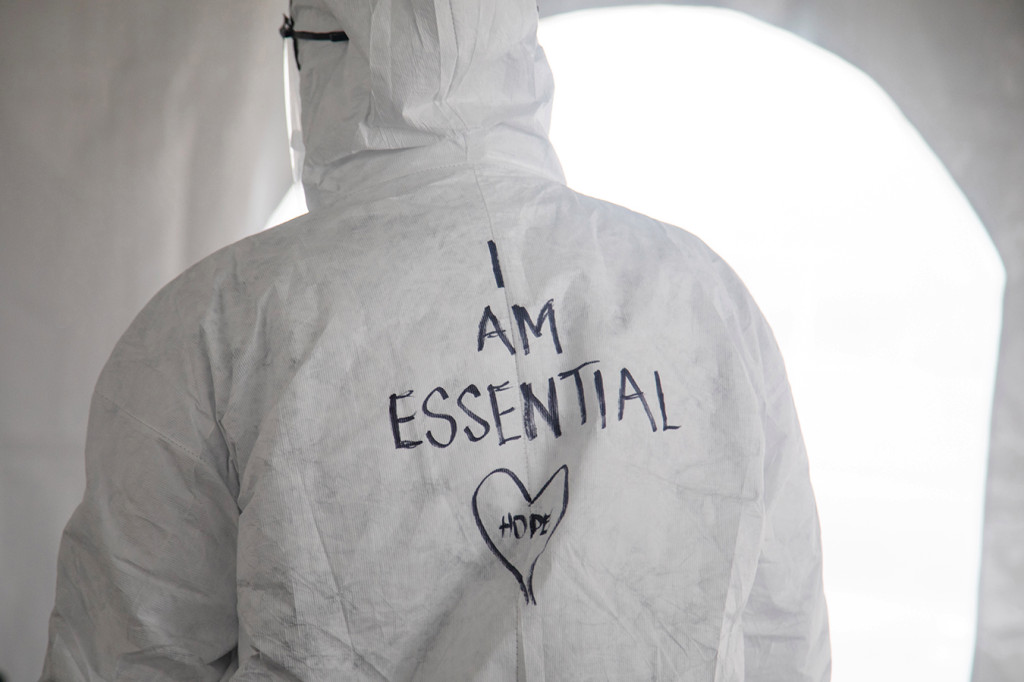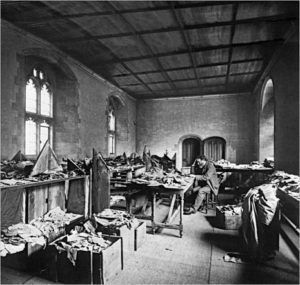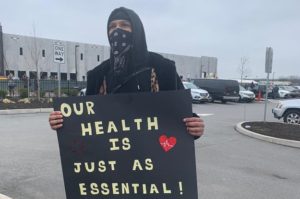Freeing Workers: Labor and Plague in the Islamic World
Do histories of slavery during earlier epidemics teach us anything about "essential workers" today?

Photographer: Emily Elconin for Getty Images
In the second week of quarantine in Chicago, I spent a day studying medieval slavery. I was organizing files on my computer (about the only thing I felt I had the capacity to do besides read the news and check in with friends and family) when I started reading one of the PDFs that had been lingering on my desktop: a roundup of scholarship about slavery in the medieval Middle East. The following passage caught my eye:
Geniza records and Arabic documents demonstrate that free Jewish and Muslim women commonly owned female slaves. …The ways in which female slave owners used their slaves, and the terms by which they occasionally freed them, demonstrate that both mastery and patronage culture were themselves gendered.
Buried in a long footnote was an article I noticed for its mention of the sea: “An Arabic Will Written on a Ship.” A minute later, I was staring at a photograph of a 1300-year-old document written on papyrus – a document that may have determined the fate of an enslaved woman. The papyrus had several holes, and the top portion is missing entirely, but the remainder of the document contains a letter from a woman to her relative, potentially her child, requesting that her home and vineyard not be sold after her death. Rather, she decided that her companion on the ship — likely her slave — should live in her home, and the revenue of the land should provide for her. Though this is conjecture, the language of the letter suggests it is a waqf (وقف), or deed for an Islamic endowment.
The author wrote her will while she and her companion were “imprisoned on our vessels” (و قد سجنا في مراكبنا), presumably onboard a ship that was prevented from pulling into port. The scholar who wrote about this will, Alia Hanafi, could only speculate that it was a plague epidemic that prompted eighth-century authorities to keep this ship from docking. Later in the letter, the author prays: “I ask Allah to better our companionship, our health, and our journey.”
 Reading about that eighth-century vessel, I could not help but think of the two cruise ships, one in Yokohama and one in the San Francisco Bay, where people were quarantined in February and March this year. According to the New York Times, while the Diamond Princess cruise ship waited off-shore for the cruise company and Japanese government to agree on who was in charge, the work of caring for the 2,700 passengers on board fell to 1,000 low-paid ship workers who were not provided with adequate safety gear or instructions.
Reading about that eighth-century vessel, I could not help but think of the two cruise ships, one in Yokohama and one in the San Francisco Bay, where people were quarantined in February and March this year. According to the New York Times, while the Diamond Princess cruise ship waited off-shore for the cruise company and Japanese government to agree on who was in charge, the work of caring for the 2,700 passengers on board fell to 1,000 low-paid ship workers who were not provided with adequate safety gear or instructions.
Juxtaposing these two situations led me to ask a new question. While slavery is not redeemable in any way, the author of the maritime will decided she owed her slave, the woman she depended on for care and survival, everything. Did any passenger on board the Diamond Princess show a similar kind of gratitude to the unprotected, untrained, and underpaid workers who risked their lives to feed and protect them?
In the days after I read the maritime will, my mind returned to the two women mentioned in the document. For how long had the author of that maritime will planned to free and endow her slave? Was she herself ill — and was this will written on her deathbed? Did she fear illness, if they were indeed quarantined? And what were these moments like for the enslaved woman who was suddenly promised freedom, a home, and productive land? Was the quarantine (if that’s what it was) an experience that transformed the relationship between these two women —master and slave?
The words of those writing or dictating this will were not meant for an audience in the distant future. But documents like this still hold for us a pull, a way into a narrative, and occasionally an example. Someone back then was in a situation that I can relate to — maybe if I know how they managed, it will help me to manage now. This impulse to study the “lessons of history” seems almost commonsense.
But there is another, competing impulse to say that things were much worse in the past, and modern people are much better and smarter now. However, a modern reader’s distance from the past — and from this slave-owning woman — is also more possible for those of us able to distance ourselves from the laborers enabling our present lives. I will not ethically evaluate our lives today in neoliberal and neoimperialist economies according to a medieval yardstick. These were fundamentally different societies with regards to labor, citizenship, state intervention, “human rights,” and any number of relevant issues. But as the unequal burdens of COVID-19 grow, those of us who are surviving by the risk-laden labor of others may be inspired to act by learning about voluntary acts of generosity and protection. It is strange to read of this generosity coming from people we find morally repugnant, like slave-owners, but the strangeness of history can be powerful when we “let ourselves be taken and shaken by other settings.”
What follows are stories of how medieval people behaved towards the workers who kept them alive when faced with calamity and death. Unlike modern European and American epidemics, we can only access these stories through fragments — but let us attend to these fragments.
***
Writing this in the U.S., where the word slavery conjures deeply painful histories for so many Black and Indigenous people, our primary association with slavery is the trans-Atlantic slave trade. And as so many have said before, this past is not past. However, slavery was not one homogenous experience in all places and times. A few scholars go so far as to say this English term has no one coherent meaning for the pre-modern Islamic world. Different slaveries also have different kinds of legacies. For example, in Egypt and other parts of the Middle East, people continue to use the racist term ‘abīd (slaves) against Sudanese and other Black people; other historical terms for slaves with different connotations, like mamlūk and jāriya, have no such uses in this region today.
Those enslaved in the pre-modern Islamic world did not live under the same conditions as enslaved people in the Atlantic world. Slaves were a legal category of people (not chattel) with certain rights. An enslaved woman who gave birth to her master’s child was automatically emancipated, and her child was free. Masters and slaves were sometimes of the same “race” and religion. The same religious legal traditions that allowed for and regulated slavery also compelled owners to free their slaves: a highly virtuous deed. However, slavers in the Eastern Mediterranean also commonly abducted, bought and sold their racial Others, including “Circassians,” Nubians, Indians and sub-Saharan Africans.
There is a decades-long, Islamophobic tradition of studying “the history of Eastern racism with the clear aim of establishing moral equivalencies with the racism of the West.” Even though specific kinds of slavery in these regions provided the enslaved with greater mobility, power, or wealth, we should never diminish the harms, alienations, and oppressions of any kind of slavery.
In plague-stricken fifteenth-century Cairo, “most of the deaths were among children, servants and slaves,” many of whom died while sustaining the lives of those around them. During the COVID-19 pandemic, essential workers are more vulnerable to illness and death than those who are able to work from home. With an estimated “29% of Americans able to work from home, social distancing is a luxury . . . largely reserved for America’s higher earners.” What conditions are we sending others to work in, and what are we doing to protect them when their employers do not?
***
Freeing one’s slaves as a final virtuous deed before death was a trope in medieval writing about the plague, such as the Treatise Informing About the Plague written by Ibn al-Wardi in fourteenth-century Aleppo:
One person entrusts his children to others; another bids his neighbors farewell.
Another orders his affairs; another prepares his own shroud.
Another reconciles with enemies; another is sweet to his friends.
Another spends generously; another befriends his former betrayer.
Another sets aside his money for good deeds; another frees his slaves.
The plague in Aleppo eventually killed Ibn al-Wardi. These verses reflect a common notion in the medieval Mediterranean world: “sickness as both punishment and treatment.” On the one hand, illnesses and plague were seen as the effects of sin, and, on the other, it was God’s testing of souls and a means to spiritual health. Those who were generous on their deathbeds may have been motivated by a desire to lighten the weight of their sins and achieve greater spiritual heights after death.

Cairo Geniza
We know about deathbed wills from a rare kind of archive, the Cairo Geniza, where a millennium of documents were preserved in a “scrap pile” of used paper in the back room of a synagogue in Fustat, Cairo. This multilingual archive is challenging to read, full of fragmented and crumpled paper, but it includes rare kinds of documents that don’t often survive from this period — including drafts of letters, prescriptions, and wills. It is a data pool of such magnitude as to provide scholars with unprecedented insight into everyday histories.
Domestic slavery was simultaneously hierarchical and intimate. The character of a domestic slave mattered greatly to her owner; she was sometimes closer to her owner than the owner’s relatives. Female domestic slaves worked primarily as caretakers for their mistresses and their children. While she was disempowered and subordinated, the domestic slave was not an easily replaced, disposable laborer.
But no matter how dutiful a domestic slave was, her labor did not always result in manumission. Two surviving deathbed wills of women in twelfth and thirteenth century Egypt survive from the Cairo Geniza and both women mention their female slaves in their wills. The former ensures that her child’s beloved Sudanese nurse, Sa’adah, will not be separated from her, by willing Sa’adah to be her daughter’s property. The latter, Sitt al-Dalal, said her slave Muna had “attended graciously to me during this and previous illnesses in ways that my mother and sister have not done,” and thus must not be sold or harmed. While one could suggest that a queer relationship existed between these women, no scholars have yet analyzed these relationships with such a lens.
Other slaves during this time worked on ships, including slave ships, and were seen as transmitting disease far and wide. During a plague in fifteenth-century Cairo, historian al-Maqrizi noted the numbers of people who had boarded a slave ship, and how few of them had survived to disembark, only to die in the port soon after arrival. The majority of these deaths were among the enslaved.
The fear of ships as vectors of disease continues. Workers on commercial ships today have not been allowed to disembark during the coronavirus pandemic and are being asked to continue working even though their contracts have ended. Others have been quarantined far from home with no source of income. Though these laborers are working in high risk environments, we don’t often read about these “unsung heroes who are moving . . . goods from point A to point B” in global supply chains whose labor is distant from most consumers.
***
Reading about these scenarios has made me think about the people who are keeping me alive in this quarantine — the many workers who are showing up to grocery stores, those who are keeping them stocked here and abroad, the healthcare providers, the people putting together field hospitals, the people keeping the electricity on and water flowing, the people fighting for student workers like myself to have increased support from our universities.
 What do I owe the workers who provide me with clean tap water, electricity, and well-stocked grocery stores? Their work puts them at increased risk right now. Despite massive socioeconomic and health inequalities in America, capitalism is supposed to make this risk “fair.” But the results of inequality — the uneven shares of illness and loss — are stark and immediate. Essential workers, especially those taking public transportation, are dying at higher rates. Together with preexisting conditions and comorbidities, this helps explain the unequal health outcomes for Black and Latinx people. Living near the University of Chicago, I think of my Black neighbors, many living further south, who are disproportionally dying from COVID-19 in this city and others like them across the country. City officials are trying to partner with community organizations to address this, but these organizations need additional help.
What do I owe the workers who provide me with clean tap water, electricity, and well-stocked grocery stores? Their work puts them at increased risk right now. Despite massive socioeconomic and health inequalities in America, capitalism is supposed to make this risk “fair.” But the results of inequality — the uneven shares of illness and loss — are stark and immediate. Essential workers, especially those taking public transportation, are dying at higher rates. Together with preexisting conditions and comorbidities, this helps explain the unequal health outcomes for Black and Latinx people. Living near the University of Chicago, I think of my Black neighbors, many living further south, who are disproportionally dying from COVID-19 in this city and others like them across the country. City officials are trying to partner with community organizations to address this, but these organizations need additional help.
Historians have offered us much to think about now. Many point to the way disease is often configured as foreign and the deadly effects this kind of xenophobia already had for Chinese-Americans in San Francisco at the turn of the last century. This othering was perpetuated by a century of films, which have represented the invisible threat in racialized ways.
Still others ask us to contemplate the fact that, because of the coronavirus pandemic, fewer people have died from industrial pollution in China, while we also reckon with the future cost of the Trump administration relaxing EPA regulations to benefit select industries.
Some historians of medicine have reminded us that each epidemic is unique, and that we should not make easy comparisons with historical events because “analogies cause blindspots.” Others have offered us some conclusions from the history of epidemics, reminding us that the way societies, cities, and countries respond is often as devastating for many people as the disease itself: “Epidemics put pressure on the societies they strike . . . They reveal what really matters to a population and whom they truly value.”
Looking into the past can help us see how we can address what our society needs today. At a time when many of us feel less secure, we can set aside resources for our workers by joining local mutual-aid efforts, by supporting worker collectives and demanding more from employers, like protective equipment, paid sick-leave, increased compensation and safer working conditions.
It is easier for those of us born into a world where slavery can only continue illegally to look at medieval slave-owners and feel the horror of their choice to turn a person into property. But several slave-owners looked death in the face and decided to give the entirety of their property to the same people they had once bought.
It is harder to identify ourselves with these medieval people and ask, would each of us have done the same? Or would we have held tighter to what we consider to be ours? We are all embedded in labor relationships, and right now the care we take for each other can mean the difference between life and death. In the face of fear and loss, we could channel these fears towards greater generosity, greater connection with those whose labor is helping us survive, those physically near and distant. We can inculcate a broader sense of who our neighbors are, whom we have claims on, and who has claims on us.
Many people writing about our responsibilities now consider us to be citizens as well as organisms who can infect and be infected: “At the individual level, our responsibilities . . . include the responsibility to wash hands, to stay at home, to cover mouths and noses when coughing or sneezing, but also to be informed and not to panic.” But we could also make more radical claims about our responsibilities to each other – that each of us owes more to the workers keeping us alive than simply paying for services.
Confronted with the looming specter of mortality, how far can we go in our generosity — and can we measure up to the slave-owning woman quarantined on an 8th-century ship? It is a terrifying thing to contemplate putting oneself and one’s loved ones at risk by going out to work or volunteer when one has the choice — but is it right that some of us have this choice because of wealth and privilege, and some do not? When we think about the past through the actions of ordinary people in times of calamity, their traces may point us towards actions more surprising and transformative than the advice offered to us by voices in the present.
Shireen Hamza is a doctoral candidate in the History of Science at Harvard University, working on the history of medicine and sexuality in the premodern Islamic world. She is also a managing editor of the Ottoman History Podcast and editor-in-chief of Ventricles, a podcast on science, religion and culture.